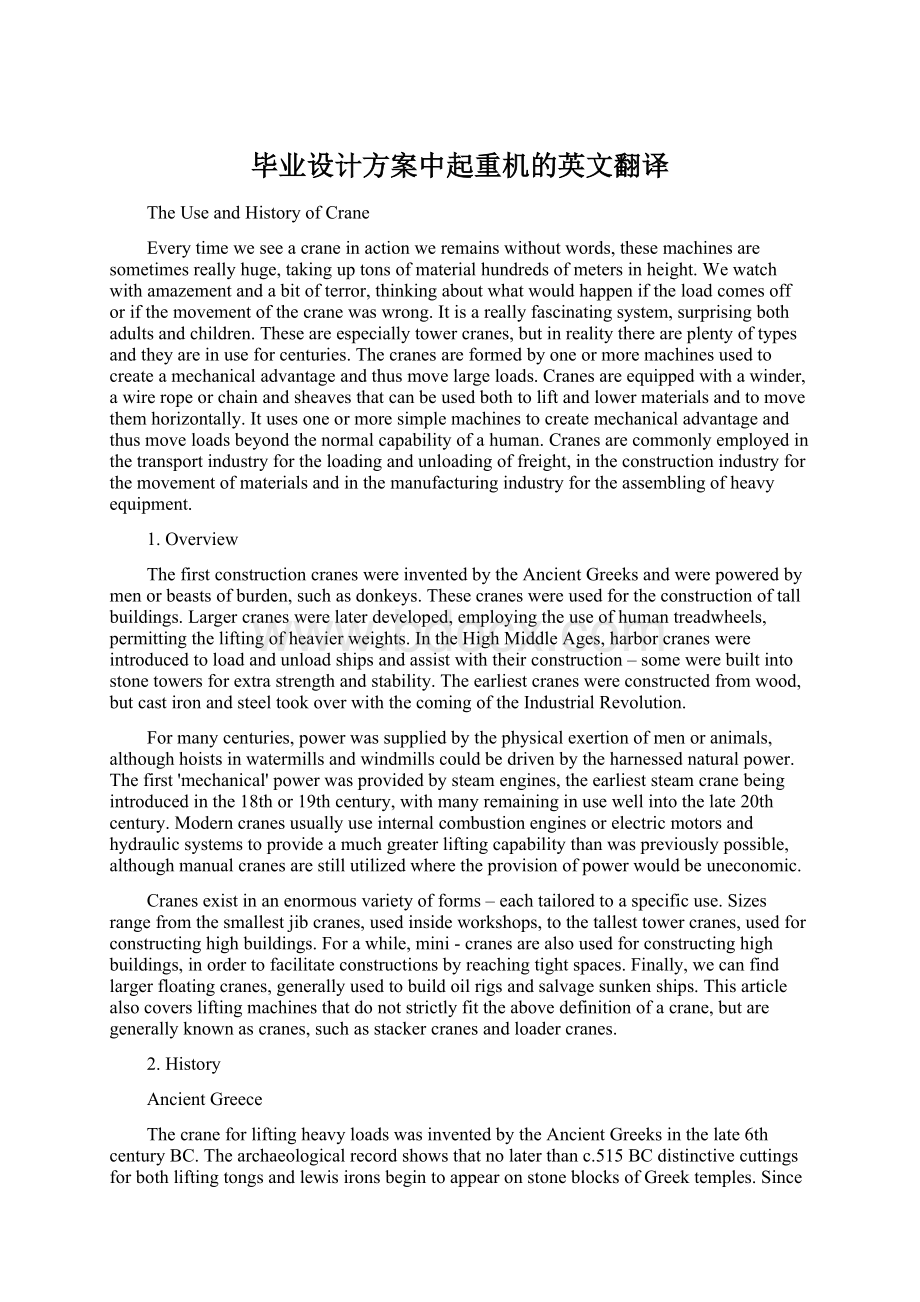毕业设计方案中起重机的英文翻译Word文件下载.docx
《毕业设计方案中起重机的英文翻译Word文件下载.docx》由会员分享,可在线阅读,更多相关《毕业设计方案中起重机的英文翻译Word文件下载.docx(7页珍藏版)》请在冰豆网上搜索。

ThefirstconstructioncraneswereinventedbytheAncientGreeksandwerepoweredbymenorbeastsofburden,suchasdonkeys.Thesecraneswereusedfortheconstructionoftallbuildings.Largercraneswerelaterdeveloped,employingtheuseofhumantreadwheels,permittingtheliftingofheavierweights.IntheHighMiddleAges,harborcraneswereintroducedtoloadandunloadshipsandassistwiththeirconstruction–somewerebuiltintostonetowersforextrastrengthandstability.Theearliestcraneswereconstructedfromwood,butcastironandsteeltookoverwiththecomingoftheIndustrialRevolution.
Formanycenturies,powerwassuppliedbythephysicalexertionofmenoranimals,althoughhoistsinwatermillsandwindmillscouldbedrivenbytheharnessednaturalpower.Thefirst'
mechanical'
powerwasprovidedbysteamengines,theearlieststeamcranebeingintroducedinthe18thor19thcentury,withmanyremaininginusewellintothelate20thcentury.Moderncranesusuallyuseinternalcombustionenginesorelectricmotorsandhydraulicsystemstoprovideamuchgreaterliftingcapabilitythanwaspreviouslypossible,althoughmanualcranesarestillutilizedwheretheprovisionofpowerwouldbeuneconomic.
Cranesexistinanenormousvarietyofforms–eachtailoredtoaspecificuse.Sizesrangefromthesmallestjibcranes,usedinsideworkshops,tothetallesttowercranes,usedforconstructinghighbuildings.Forawhile,mini-cranesarealsousedforconstructinghighbuildings,inordertofacilitateconstructionsbyreachingtightspaces.Finally,wecanfindlargerfloatingcranes,generallyusedtobuildoilrigsandsalvagesunkenships.Thisarticlealsocoversliftingmachinesthatdonotstrictlyfittheabovedefinitionofacrane,butaregenerallyknownascranes,suchasstackercranesandloadercranes.
2.History
AncientGreece
ThecraneforliftingheavyloadswasinventedbytheAncientGreeksinthelate6thcenturyBC.Thearchaeologicalrecordshowsthatnolaterthanc.515BCdistinctivecuttingsforbothliftingtongsandlewisironsbegintoappearonstoneblocksofGreektemples.Sincetheseholespointattheuseofaliftingdevice,andsincetheyaretobefoundeitherabovethecenterofgravityoftheblock,orinpairsequidistantfromapointoverthecenterofgravity,theyareregardedbyarchaeologistsasthepositiveevidencerequiredfortheexistenceofthecrane.
Theintroductionofthewinchandpulleyhoistsoonleadtoawidespreadreplacementoframpsasthemainmeansofverticalmotion.Forthenexttwohundredyears,Greekbuildingsiteswitnessedasharpdropintheweightshandled,asthenewliftingtechniquemadetheuseofseveralsmallerstonesmorepracticalthanoffewerlargerones.Incontrasttothearchaicperiodwithitstendencytoever-increasingblocksizes,GreektemplesoftheclassicalageliketheParthenoninvariablyfeaturedstoneblocksweighinglessthan15-20tons.Also,thepracticeoferectinglargemonolithiccolumnswaspracticallyabandonedinfavorofusingseveralcolumndrums.
Althoughtheexactcircumstancesoftheshiftfromtheramptothecranetechnologyremainunclear,ithasbeenarguedthatthevolatilesocialandpoliticalconditionsofGreeceweremoresuitabletotheemploymentofsmall,professionalconstructionteamsthanoflargebodiesofunskilledlabor,makingthecranemorepreferabletotheGreekpolisthanthemorelabor-intensiverampwhichhadbeenthenormintheautocraticsocietiesofEgyptorAssyria.
ThefirstunequivocalliteraryevidencefortheexistenceofthecompoundpulleysystemappearsintheMechanicalProblems(Mech.18,853a32-853b13>
attributedtoAristotle(384-322BC>
butperhapscomposedataslightlylaterdate.Aroundthesametime,blocksizesatGreektemplesbegantomatchtheirarchaicpredecessorsagain,indicatingthatthemoresophisticatedcompoundpulleymusthavefounditswaytoGreekconstructionsitesbythen.
AncientRome
TheheydayofthecraneinancienttimescameduringtheRomanEmpire,whenconstructionactivitysoaredandbuildingsreachedenormousdimensions.TheRomansadoptedtheGreekcraneanddevelopeditfurther.Wearerelativelywellinformedabouttheirliftingtechniques,thankstoratherlengthyaccountsbytheengineersVitruvius(DeArchitectura10.2,1-10>
andHeronofAlexandria(Mechanica3.2-5>
.TherearealsotwosurvivingreliefsofRomantreadwheelcranes,withtheHateriitombstonefromthelatefirstcenturyADbeingparticularlydetailed.
ThesimplestRomancrane,theTrispastos,consistedofasingle-beamjib,awinch,arope,andablockcontainingthreepulleys.Havingthusamechanicaladvantageof3:
1,ithasbeencalculatedthatasinglemanworkingthewinchcouldraise150kg(3pulleysx50kg=150>
assumingthat50kgrepresentthemaximumeffortamancanexertoveralongertimeperiod.Heaviercranetypesfeaturedfivepulleys(Pentaspastos>
or,incaseofthelargestone,asetofthreebyfivepulleys(Polyspastos>
andcamewithtwo,threeorfourmasts,dependingonthemaximumload.ThePolyspastos,whenworkedbyfourmenatbothsidesofthewinch,couldalreadylift3000kg(3ropesx5pulleysx4menx50kg=3000kg>
.Incasethewinchwasreplacedbyatreadwheel,themaximumloadevendoubledto6000kgatonlyhalfthecrew,sincethetreadwheelpossessesamuchbiggermechanicaladvantageduetoitslargerdiameter.Thismeantthat,incomparisontotheconstructionoftheEgyptianPyramids,whereabout50menwereneededtomovea2.5tonstoneblockuptheramp(50kgperperson>
theliftingcapabilityoftheRomanPolyspastosprovedtobe60timeshigher(3000kgperperson>
.
However,numerousextantRomanbuildingswhichfeaturemuchheavierstoneblocksthanthosehandledbythePolyspastosindicatethattheoverallliftingcapabilityoftheRomanswentfarbeyondthatofanysinglecrane.AtthetempleofJupiteratBaalbek,forinstance,thearchitraveblocksweighupto60tonseach,andonecornercorniceblockevenover100tons,allofthemraisedtoaheightofabout19m.InRome,thecapitalblockofTrajan'
sColumnweighs53.3tons,whichhadtobeliftedtoaheightofabout34m(seeconstructionofTrajan'
sColumn>
ItisassumedthatRomanengineersliftedtheseextraordinaryweightsbytwomeasures(seepicturebelowforcomparableRenaissancetechnique>
:
First,assuggestedbyHeron,aliftingtowerwassetup,whosefourmastswerearrangedintheshapeofaquadranglewithparallelsides,notunlikeasiegetower,butwiththecolumninthemiddleofthestructure(Mechanica3.5>
.Second,amultitudeofcapstanswereplacedonthegroundaroundthetower,for,althoughhavingalowerleverageratiothantreadwheels,capstanscouldbesetupinhighernumbersandrunbymoremen(and,moreover,bydraughtanimals>
.ThisuseofmultiplecapstansisalsodescribedbyAmmianusMarcellinus(17.4.15>
inconnectionwiththeliftingoftheLateranenseobeliskintheCircusMaximus(ca.357AD>
.Themaximumliftingcapabilityofasinglecapstancanbeestablishedbythenumberoflewisironholesboredintothemonolith.IncaseoftheBaalbekarchitraveblocks,whichweighbetween55and60tons,eightextantholessuggestanallowanceof7.5tonperlewisiron,thatispercapstan.Liftingsuchheavyweightsinaconcertedactionrequiredagreatamountofcoordinationbetweentheworkgroupsapplyingtheforcetothecapstans.
MiddleAges
DuringtheHighMiddleAges,thetreadwheelcranewasreintroducedonalargescaleafterthetechnologyhadfallenintodisuseinwesternEuropewiththedemiseoftheWesternRomanEmpire.Theearliestreferencetoatreadwheel(magnarota>
reappearsinarchivalliteratureinFranceabout1225,followedbyanilluminateddepictioninamanuscriptofprobablyalsoFrenchorigindatingto1240.Innavigation,theearliestusesofharborcranesaredocumentedforUtrechtin1244,Antwerpin1263,Bruggein1288andHamburgin1291,whileinEnglandthetreadwheelisnotrecordedbefore1331.
Generally,verticaltransportcouldbedonemoresafelyandinexpensivelybycranesthanbycustomarymethods.Typicalareasofapplicationwereharbors,mines,and,inparticular,buildingsiteswherethetreadwheelcraneplayedapivotalroleintheconstructionoftheloftyGothiccathedrals.Nevertheless,botharchivalandpictorialsourcesofthetimesuggestthatnewlyintroducedmachinesliketreadwheelsorwheelbarrowsdidnotcompletelyreplacemorelabor-intensivemethodslikeladders,hodsandhandbarrows.Rather,oldandnewmachinerycontinuedtocoexistonmedieva